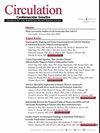与轻度和迟发性表型相关的LMNA突变:荷兰创始人突变p.(Arg331Gln)的案例。
引用次数: 4
摘要
本文章由计算机程序翻译,如有差异,请以英文原文为准。
LMNA Mutations Associated With Mild and Late-Onset Phenotype: The Case of the Dutch Founder Mutation p.(Arg331Gln).
Cardiolaminopathies are autosomal dominant genetic diseases caused by mutations in the LMNA gene which encodes the nucleus envelope protein Lamin AC.1 There are now 12 phenotypes associated with LMNA mutations, both autosomal dominant and recessive, the majority of which have cardiac involvement (http://omim.org/entry/150330). These include dilated cardiomyopathy (DCM) associated with conduction disease, atrial and ventricular arrhythmias, and phenotypes mimicking arrhythmogenic right ventricular cardiomyopathy.2
See Article by Hoorntje et al
Cardiolaminopathies are characterized by high arrhythmogenic risk3 that may manifest in mildly dilated hearts and may be the first clinical presentation of the disease. Fatal arrhythmias may occur even when left ventricular dysfunction does not reach the cutoff value established by guidelines for implantable cardioverter–defibrillator implantation for the primary prevention of sudden death.4 Clinical cardiologists involved in programs dedicated to familial cardiomyopathies are well aware of the arrhythmogenic risk of cardiolaminopathies. The latest ESC Guidelines for primary prevention of sudden cardiac death recommend (Class IIa; Level of Evidence B) implantable cardioverter–defibrillator in patients with DCM, a confirmed disease-causing LMNA mutation, and the following clinical risk factors: nonsustained ventricular tachycardia during ambulatory electrocardiographic monitoring, left ventricular ejection fraction <45% on initial evaluation, male sex, and nonmissense mutations.5
The genetic diagnosis of laminopathy in DCM patients impacts therapeutic and prognostic strategies. For example, the percutaneous catheter ablation of sustained monomorphic ventricular tachycardia in LMNA cardiomyopathy could be an important consideration. Poor outcomes, including high rates of recurrence of arrhythmia, progression to end-stage heart failure, and high mortality, have been reported in patients with cardiolaminopathies, wherein 91% of patients experienced ≥1 ventricular tachycardia recurrence, 44% received or were awaiting mechanical circulatory support or transplant for end-stage heart failure, and 26% died during a median 7-month follow-up.6 Use of β-blockers in conduction disease should be postponed until after pacemaker …
求助全文
通过发布文献求助,成功后即可免费获取论文全文。
去求助
来源期刊

Circulation: Cardiovascular Genetics
CARDIAC & CARDIOVASCULAR SYSTEMS-GENETICS & HEREDITY
自引率
0.00%
发文量
0
审稿时长
6-12 weeks
期刊介绍:
Circulation: Genomic and Precision Medicine considers all types of original research articles, including studies conducted in human subjects, laboratory animals, in vitro, and in silico. Articles may include investigations of: clinical genetics as applied to the diagnosis and management of monogenic or oligogenic cardiovascular disorders; the molecular basis of complex cardiovascular disorders, including genome-wide association studies, exome and genome sequencing-based association studies, coding variant association studies, genetic linkage studies, epigenomics, transcriptomics, proteomics, metabolomics, and metagenomics; integration of electronic health record data or patient-generated data with any of the aforementioned approaches, including phenome-wide association studies, or with environmental or lifestyle factors; pharmacogenomics; regulation of gene expression; gene therapy and therapeutic genomic editing; systems biology approaches to the diagnosis and management of cardiovascular disorders; novel methods to perform any of the aforementioned studies; and novel applications of precision medicine. Above all, we seek studies with relevance to human cardiovascular biology and disease.
 求助内容:
求助内容: 应助结果提醒方式:
应助结果提醒方式:


